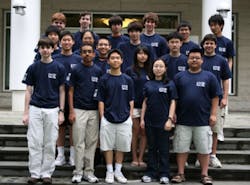SCIENCE & TECHNOLOGY EDUCATION: The International Physics Olympiad encourages young physics students
GRACE KLONOSKI
Each year some of the top high school physics students in the United States step into the international spotlight when, as members of the U.S. Physics Team, they represent their country at the International Physics Olympiad Competition. The team members are chosen in a rigorous national competition sponsored by the American Association of Physics Teachers (AAPT) and the American Institute of Physics (AIP).
The 2009 U.S. team, which competed against teams of high school students from 70 nations at the 40th International Physics Olympiad held July 12-19 in Merida, Yucatan, Mexico, won four gold medals and one silver medal, tying with India and Korea for second place overall in the medal count.
The team selection process begins in early January, when high schools register their students to participate in the F=ma exam. Approximately 400 top scorers advance to the next round of competition, the quarter-finals. An exam is used to select the 24 semifinalist members of the U.S. Physics Team, who undergo nine days of classes, coaching, labs, special lectures, and exams at the U.S. Physics Team Training Camp at the University of Maryland at the end of May. Five team members are then chosen as the Traveling Team to represent the U.S. at the Olympiad. The Traveling Team returns to College Park for three additional days of intense laboratory work before heading to the international event.
Each national delegation is composed of five students from general or technical secondary schools (not colleges or universities) and two leaders. Observers may also accompany a national team. The students compete as individuals in two five-hour days of examinations separated by at least one day of rest. One day is devoted to theoretical problems (three problems involving at least four areas of physics taught in secondary schools); the second day is devoted to experimental problems (one five-hour problem or two problems, which together take up the full five hours). Medals are awarded based on points accumulated over the two days of competition. The top 8% of the participants are given Gold Medals; Silver Medals are awarded to the top 25%; the top 50% get Bronze Medals, Honorable Mentions go the top 67%, and all other participants receive certificates of participation. The student competitor with the highest score (Absolute Winner) receives a special prize, in addition to a Gold Medal.
The first International Physics Olympiad was organized in 1967 in Eastern Europe. Western nations began competing in the 1970s, and the U.S. program was started in 1986 under the direction of the AAPT Executive Officer, Jack Wilson. The goals of the U.S. Program are to:
- encourage excellence in physics education and to reward outstanding physics students;
- expand awareness of and participation in the program;
- provide a meaningful scientific and cultural experience for team members, including opportunities to network and meet new people, learn in intellectual and experiential ways, and gain international exposure;
- and win medals and compete successfully on an international level.
Winning medals is only one way to measure the success of the program, says the AAPT. It points to the impact the program has had on the students' personal development. One comment by a student on a survey taken after summer camp highlights the intangible benefits of the program: "During those days in Maryland, I was given a tremendous opportunity to see into the heart of the physics community. I listened to respected researchers discuss their work. More importantly, I felt myself reaching the limits of my abilities, of my intelligence."
The 2009 U.S. Physics Traveling Team members are David Field, a sophomore at Phillips Andover Academy in Andover, MA; Bowei Lui, a sophomore at Mission San Jose High School in Fremont, CA; Marianna Mao, a senior at Mission San Jose High School in Fremont, CA; Anand Natarajan, a senior at The Harker School in San Jose, CA; and Joshua Oreman, a senior at Harvard Westlake School in Los Angeles, CA.
A number of scientific societies, corporations, and individuals help sponsor the U.S Physics team. The Optical Society of America is an enthusiastic financial sponsor of the Olympiad, as its mission and activities are well-aligned with those of the OSA Foundation. For more information about the U.S. Physics Team, contact the AAPT Programs and Conferences Department at (301) 209-3344 or [email protected].
The OSA Foundation was established in 2002 to support philanthropic activities that help further the Optical Society's mission by concentrating its efforts on programs that advance youth science education, provide optics education and resources to underserved populations, provide career and professional development resources and support awards and honors that recognize technical and business excellence. The grants funded by the OSA Foundation are made possible by the generous donations of its supporters as well as the dollar-for-dollar match by OSA. The Foundation is exempt from U.S. federal income taxes under section 501(c)(3) of the Internal Revenue Code and is a public charity. To learn more about the OSA Foundation and to make a contribution to this or other Foundation programs, please visit www.osa-foundation.org or e-mail [email protected].
Grace Klonoski is the Senior Director, Foundation, Membership & Education Services for the Optical Society of America, 2010 Massachusetts Ave, NW, Washington, DC 20036; email: [email protected]; Web site: www.osa.org